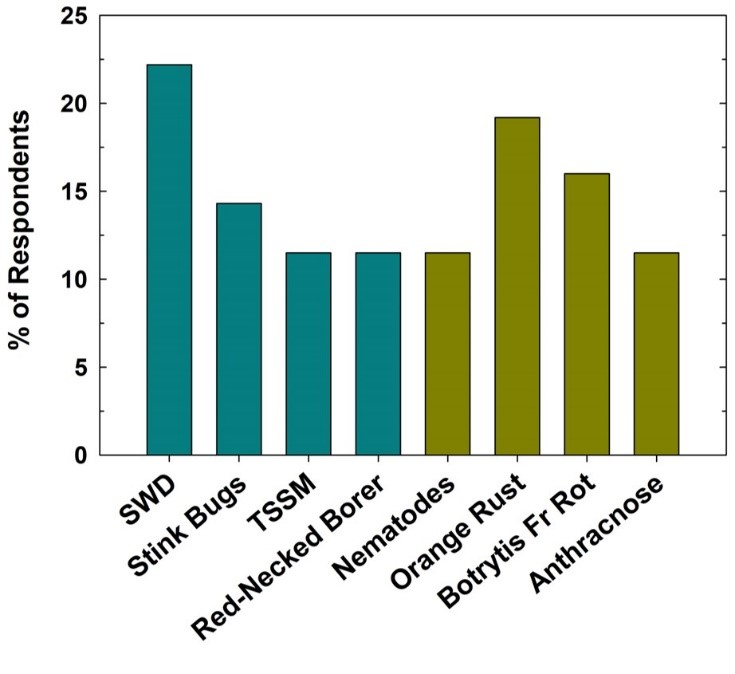Dr. Sara Villani, Extension Specialist (Apple and Ornamental Plant Pathology), North Carolina State University

On January 12, 2020 (before large gatherings came to a halt), blackberry stakeholders from states across the Southern U.S. gathered in Savannah GA to develop a Pest Management Strategic Plan (PMSP) for Blackberries in the Southern U.S.. Led by Dr. Gina Fernandez, Professor and Extension Specialist in the Department of Horticultural Science at NCSU, blackberry stakeholders from nine states participated in outlining current production practices, major concerns, and management paradigms for fresh market blackberries and developing research, extension, and production priorities for the Southern blackberry industry. Prior to the meeting, a survey was sent to stakeholders to more accurately quantify current and upcoming needs and concerns of blackberry producers. The remainder of this article will address survey results and FAQs associated with the PMSP.
What is a PMSP and where can I see an example of one?
A PMSP, or “Pest Management Strategic Plan”, is a plan developed by stakeholders (e.g. extension specialists, extension agents, consultants, growers) to identify pest management needs. Plans usually have a specific focus on locations (state, regional, national), and type of crop and production system-in this case “fresh market blackberries”. In a collaborative effort by stakeholders, a pest-by-pest approach is used to identify current and future management strategies under development (chemical and non-chemical approaches).
If you want a better idea of what one looks like head to: www.southernipm.org and then click on “IPM DATA” (top right choice). From there finding examples of already published PMSPs should be fairly self-explanatory. Our Blackberry PMSP unfortunately is not yet available on the website.
Who is participating in development of the PMSP?
Stakeholders from nine southern states: VA, NC, SC, GA, AL, TN, MS, AR, and LA have been invited to participate. In addition, funding and/or representation from the Southern IPM Center, the IR-4 Project, and the Southern Region Small Fruit Consortium have been imperative for the development of this strategic plan.
Why spend our time developing a PMSP?
Besides being an interesting read the PMSP will actually be utilized by a number of regulatory agencies and the research and extension community. For example:
- Utilization by the EPA for labeling or relabeling pesticides.
- Utilization by the IR-4 program to evaluate efficacy and potential of pesticides that are currently not registered for blackberry
- Creates a set of priorities for blackberry production and pest management that can be utilized by University researchers and extension specialists for grant development
- Provides recognition of a rapidly expanding blackberry industry in the Southern US
What are the current and future concerns of southern blackberry producers?
In the fall of 2019, 43 blackberry stakeholders (primarily growers) across the nine participating southern states completed a survey sent out by the University of Arkansas (lead by Dr. Margaret Worthington). Members of the blackberry industry were asked to rate their level of concern for certain pests, diseases, and cultural/production issues in blackberry. Those that were among the “top concerns” or that were predicted to become a major concern in the future are characterized below.
Top Current (2019) Pest and Disease Concerns for Southern Blackberry Growers

Top Current (2019) Cultural Management / Crop Production Concerns for Southern Blackberry Growers

Top Future Concerns Pest and Disease Management in Southern Blackberries

Top Future Concerns for Cultural Management and Crop Production in Southern Blackberries

Can you tell me more about the PMSP Meeting in Savannah this past January?
The Blackberry PMSP Development Meeting was timed with the Southeastern Regional Fruit and Vegetable Conference in Savannah GA on January 12, 2020. Thirty-one stakeholders joined this collaborative effort including representatives from all states within the SRSFC, NARBA, IR4, and the Southern IPM Center. Besides populating the PMSP spreadsheets to highlight disease, insect, and production issues for southern blackberry growers a list of critical priorities was set by those in attendance.
Five Critical Priorities for Research, Regulatory, and Stakeholder Education
- Expansion of the Sandia herbicide label
- Monitoring for fungicide resistance in pathogens (especially Botrytis cinerea)
- Bridging the gap of floricane and primocane fruiting with new late floricane fruit varieties, early primocane fruiting varieties, or cultural practices
- Practices to reduce labor and increase efficiency
- SWD insecticide research: Additional/multiple modes of action; insecticides with a shorter PHI; resistance management paradigms